

What is the thinking behind this approach? / Encourage Positive Behaviours / Welcome - Positive Behaviour for Learning. At an individual, classroom, and centre level . . .

Behaviour is not "good" or "bad". It serves a purpose because it pays off in some way and is weakened or reinforced by what happens after. If you want to support a child or young person to improve, you need to understand the relationship between the behaviour and its purpose. Children and young people can be resilient and can do well despite adverse circumstances. Teachers can support resilience. Culture. You are here: A school’s culture consists of the customs, rituals, and stories that are evident and valued throughout the whole school.
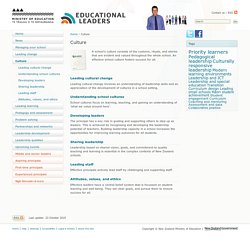
An effective school culture fosters success for all. A Positive Culture of Support: PB4L School-Wide Final Evaluation Report. This report summarises the findings from the final phase of an evaluation of Positive Behaviour for Learning (PB4L) School-Wide.

It describes the extent of implementation of School-wide in Schools, identifies short-term shifts and considers the longer term sustainability of the initiative. Author(s): Sally Boyd and Rachel Felgate, New Zealand Council for Educational Research. Support material / PB4L School-Wide / Welcome - Positive Behaviour for Learning.
The interactive PDFs below will allow you to create and complete your own electronic versions of activities, forms, and checklists from the manual.
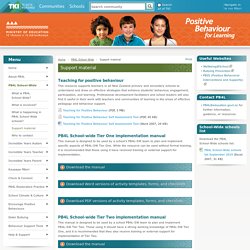
Type into the fillable fields (which are coloured on screen but print as they appear in the manual), and then save the document as a record, to work on in the future, or to email to others. Print the documents for hard copy records of what you’ve typed or if you would prefer to create handwritten versions. (Note that three of the PDFs have a mixture of portrait and landscape pages. To ensure these print properly, set ‘Orientation’ to ‘Auto portrait/landscape’ in the print dialogue box.) Section 2 – Working in teams. PB4L – Positive Behaviour for Learning. Positive Behaviour for Learning (PB4L) improves the behaviour and wellbeing of children and young people.
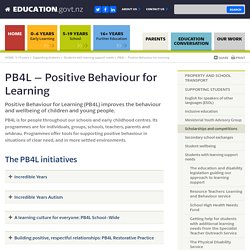
PB4L is for people throughout our schools and early childhood centres. Its programmes are for individuals, groups, schools, teachers, parents and whānau. Programmes offer tools for supporting positive behaviour in situations of clear need, and in more settled environments. Quality Circle Time - Jenny Mosley Education Training and Resources. “Children love Circle Time, Circle Time brings just the right blend of structure, enjoyment and learning!”

Quality Circle Time (QCT) is a very exciting, democratic and creative approach used to support teachers and other professionals work with pupils in managing issues that affect the whole learning community. Teaching staff, children, support staff, parents and governors can all be actively involved. Index to Group Activities, Games, Exercises & Initiatives. The Incredible Years Parenting Program in New Zealand. Incredible Years Teacher Program is Rolled out in New Zealand by the Ministry of Education. Intervention Central. The Good Behavior Game is an approach to the management of classrooms behaviors that rewards children for displaying appropriate on-task behaviors during instructional times.
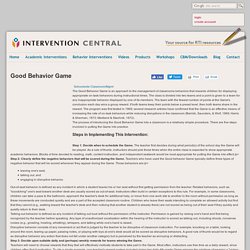
The class is divided into two teams and a point is given to a team for any inappropriate behavior displayed by one of its members. The team with the fewest number of points at the Game's conclusion each day wins a group reward. If both teams keep their points below a preset level, then both teams share in the reward. The program was first tested in 1969; several research articles have confirmed that the Game is an effective means of increasing the rate of on-task behaviors while reducing disruptions in the classroom (Barrish, Saunders, & Wolf, 1969; Harris & Sherman, 1973; Medland & Stachnik, 1972). The process of introducing the Good Behavior Game into a classroom is a relatively simple procedure. Steps in Implementing This Intervention: Step 1: Decide when to schedule the Game.
Step 5: Put the Game into effect. Kaupapa Māori / Welcome - Positive Behaviour for Learning. Māori enjoying education success as Māori means having an education system that provides all Māori students with the opportunity to realise their own unique potential and succeed in their lives as Māori.
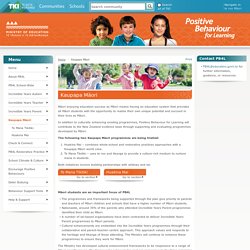
In addition to culturally enhancing existing programmes, Positive Behaviour for Learning will contribute to the New Zealand evidence base through supporting and evaluating programmes developed by Māori. The following two Kaupapa Māori programmes are being trialled: Huakina Mai – combines whole-school and restorative practices approaches with a Kaupapa Māori world view.Te Mana Tikitiki – uses te reo and tikanga to provide a culture-rich medium to nurture mana in students. Both initiatives involve building partnerships with whānau and iwi. Māori students are an important focus of PB4L The Ministry has developed cultural enhancement frameworks to be responsive to a range of Māori-specific issues.
Return to top ^ PBIS.org Home Page. Support material / PB4L Restorative Practice. Restorative Practice Model Restorative Practice Model (PDF 52KB) Kete Book One Restorative Practice Kete Book One (PDF 2.5KB) Kete Book Two Restorative Practice Kete Book Two Kete Book Three Restorative Practice Kete Book Three Knowledge Seminar: Restorative Practices in Schools 30 April 2015 In early March, Professor Chris Marshall presented a Ministry of Education Knowledge Seminar about restorative justice practices in schools.
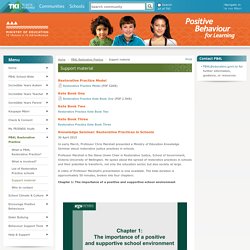
Professor Marshall is the Diana Unwin Chair in Restorative Justice, School of Government, Victoria University of Wellington. A video of Professor Marshall’s presentation is now available. What is involved? / PB4L Restorative Practice. The PB4L Restorative Practice model has three key interrelated components: Restorative Essentials, Restorative Circles and Restorative Conferences.

The first and most fundamental component is Restorative Essentials, which is built on and further developed in the use of Restorative Circles and Restorative Conferences. PB4L Restoratve Practice Model Restorative Essentials embody the approach of the PB4L Restorative Practice model at the grass roots level - the everyday, informal actions that place emphasis on relationships, respect, empathy, social responsibility and self-regulation. What is PB4L Restorative Practice? / PB4L Restorative Practice. Restorative Practice is a relational approach to school life grounded in beliefs about equality, dignity, mana and the potential of all people. The Positive Behaviour for Learning (PB4L) Restorative Practice model focuses on building and maintaining positive, respectful relationships across the school community and offers school staff best-practice tools and techniques to restore relationships when things go wrong.
By building and maintaining positive, respectful relationships within a school, staff to staff, staff to student and student to student, issues are more easily managed. Welcome - Positive Behaviour for Learning.